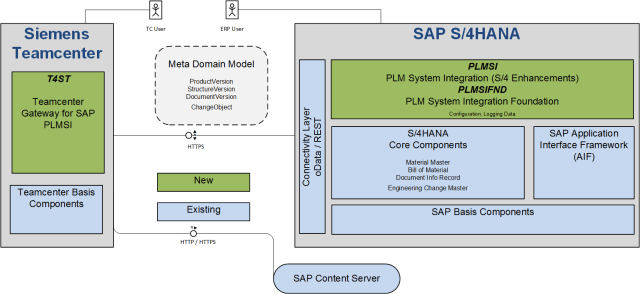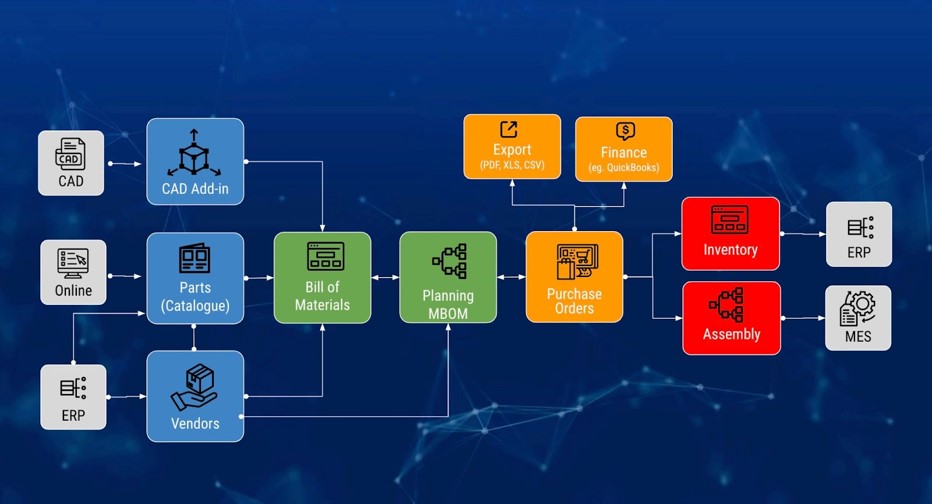
The process of transition from engineering to the manufacturing process is one of the most complex and requires a significant data management effort. From one side, we have design information that must be translated into the manufacturing and procurement plan. On the other side, we have the complexity of supply chain, purchasing, factory shop flow planning, and manufacturing operations. To bring all these things together is not a simple task. But it is required for successful integration of design into manufacturing, efficient supply chain management, connecting computer-aided design and PLM software to manufacturing bill of materials, and integrating engineering department into manufacturing processes.
When it comes to data management, it often turns into a translation of EBOM to MBOM. How to make it efficient? How to organize the data, so everyone will get what they need and will be able to use accurate data in both – engineering bills, manufacturing bills, well-organized product data management, and product lifecycle management processes?
In my blog today, I want to give examples and discuss the challenges of design to manufacturing data transformation. Although EBOM to MBOM is one of the most typical examples, it is not always so. Many companies are not formal in the way the data is transferred. One of the challenges of digital transformation in manufacturing is to digitize the process of data handover from engineering to manufacturing, making it seamless, fast, and accurate. Let’s talk about multiple use cases of EBOM to MBOM transformation in different environments.
Drawings BOM Release To Manufacturing
This is probably the most old fashion and probably one of the most popular methods even in the current digital world. Engineers release drawings and BOMs are on the drawings together with manufacturing instructions. This process is not efficient and in most, situations require re-entring BOM into one of the manufacturing systems used in the company (eg. finance, procurement, manufacturing planning, MRP, or other).
PDM/PLM to MRP Translation
One step up from just releasing drawing with BOM on it is the process when design BOM is transformed into MRP/ERP system manually or automatically during the design release process. This process performs the translation of design structure (EBOM) to manufacturing structure (MBOM). I found a good picture of this process in Jos Voskuil’s blog The importance of EBOM to MBOM translation.

While we can see already a restructuring process between EBOM and BOM, in most cases it is done by exporting data from one system and importing it to another system. Still, both systems can be pretty much disconnected and each BOM can independently be changed. The translation of data is actually can be quite painful and PLM software developers provide multiple integration services to sync data between EBOM and MBOM. It can be done using different scripts and APIs, but can be done using integration services. In the video below, you can see how vdR Nexus performs integration between Upchain and Microsoft Dynamics 365 systems.
More sophisticated EBOM to MBOM translations are possible, especially if you step into complex enterprise PLM and ERP integrations. One of the best examples is the partnership between Siemens PLM and SAP to create a seamless integration and product offering between Teamcenter PLM and SAP 4HANA. The development of the integration is ongoing already for almost 3 years. Here is an interesting article on Engineering.com written by Lionel Grealou – SAP Teamcenter Integration: First Release Out and What It Might Mean for the Competition

One PLM for both EBOM and MBOM
The idea of having both BOMs (EBOM and MBOM) managed by a single system is not new in the industry. Although, the competition between PLM and ERP always exists we can see multiple compelling cases when a single system makes total sense either from a perspective of simplicity or also in very complex use cases. The main reason for such a solution is data integration. It is always easier to manage data in a single system than integrate multiple systems. Here are a few examples.
EBOM to Purchasing (Order) BOM by OpenBOM
OpenBOM is an online system that provides a mix of PLM and ERP functions and allows to organize both BOM (EBOM) and procurement order (kind of MBOM) and keep them in sync. Check the following diagram to explain how it works. The key element of this integration is automatic sync and gap calculation between EBOM and Order (both managed by OpenBOM).

OpenBOM provides simplicity and seamless data integration between both engineering and procurement functions. Please note – I’m the co-founder and CEO of OpenBOM.
PLM Solutions for EBOM to MBOM process
To keep the process of EBOM and MBOM managed in a single system and provide a sophisticated process of creation of MBOM from EBOM exists in multiple PLM systems such as Aras, DS 3DEXPERIENCE, Teamcenter, and Windchill. Here are a few videos.
Aras Innovator:
3D EXPERIENCE
Teamcenter PLM
Windchill MPMLink
All examples show how EBOM to MBOM can be actually a very complex process that requires understanding data from both sides and careful data control to ensure the accurate data presented from both sides.
What is my conclusion?
Engineering to the manufacturing process is complex and usually requires a lot of synchronization between multiple organizations and systems in manufacturing business processes. However, having this process is extremely important for a company of any size. To ensure the process is efficient you need to focus on data first. It all starts with an accurate engineering bill of materials, ensuring that the source is of the data is stable. Once you got it, focus on product lifecycle management functions that can translate the engineering bills of materials in product lifecycle management to manufacturing bills in ERP. Connection of EBOM to MBO is essential to ensure digital processes and digital thread between engineering and manufacturing environment With the introduction of multiple SaaS PLM systems and turning BOM into. digital process, we are going to see a lot of advancement in this field in the next 3-5 years. Just my thoughts…
Best, Oleg
Disclaimer: I’m co-founder and CEO of OpenBOM developing a digital cloud-native PLM platform that manages product data and connects manufacturers, construction companies, and their supply chain networks. My opinion can be unintentionally biased.









